谈谈Java反射:从入门到实践,再到原理
前言
反射是Java底层框架的灵魂技术,学习反射非常有必要,本文将从入门概念,到实践,再到原理讲解反射,希望对大家有帮助。
反射理解
官方解析
Oracle 官方对反射的解释是:
Reflection is commonly used by programs which require the ability to examine ormodify the runtime behavior of applications running in the Java virtual machine.This is a relatively advanced feature and should be used only by developers whohave a strong grasp of the fundamentals of the language. With that caveat inmind, reflection is a powerful technique and can enable applications to performoperations which would otherwise be impossible.
Java 的反射机制是指在运行状态中,对于任意一个类都能够知道这个类所有的属性和方法;并且对于任意一个对象,都能够调用它的任意一个方法;这种动态获取信息以及动态调用对象方法的功能成为Java语言的反射机制。
白话理解
正射
万物有阴必有阳,有正必有反。既然有反射,就必有“正射”。
那么正射是什么呢?
我们在编写代码时,当需要使用到某一个类的时候,都会先了解这个类是做什么的。然后实例化这个类,接着用实例化好的对象进行操作,这就是正射。
Student student = new Student();student.doHomework("数学");
反射
反射就是,一开始并不知道我们要初始化的类对象是什么,自然也无法使用 new 关键字来创建对象了。
Class clazz = Class.forName("reflection.Student");Method method = clazz.getMethod("doHomework", String.class);Constructor constructor = clazz.getConstructor();Object object = constructor.newInstance();method.invoke(object, "语文");
正射与反射对比
以上两段代码,执行效果是一样的,如图
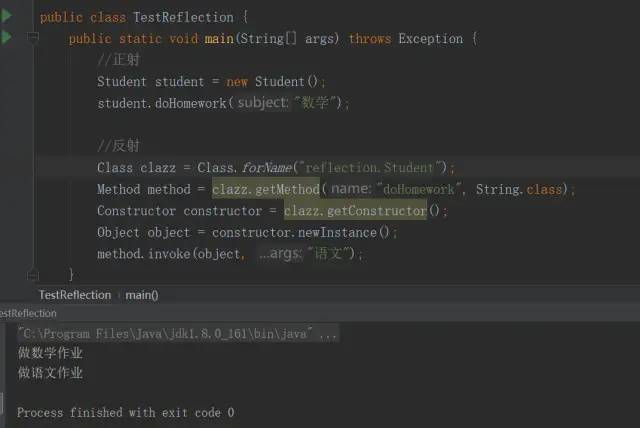
但是,其实现的过程还是有很大的差别的:
第一段代码在未运行前就已经知道了要运行的类是
Student;第二段代码则是到整个程序运行的时候,从字符串
reflection.Student,才知道要操作的类是Student。
结论
反射就是在运行时才知道要操作的类是什么,并且可以在运行时获取类的完整构造,并调用对应的方法。
Class 对象理解
要理解Class对象,我们先来了解一下RTTI吧。RTTI(Run-Time Type Identification)运行时类型识别,其作用是在运行时识别一个对象的类型和类的信息。
Java是如何让我们在运行时识别对象和类的信息的?主要有两种方式:一种是传统的RRTI,它假定我们在编译期已知道了所有类型。另一种是反射机制,它允许我们在运行时发现和使用类的信息。
每个类都有一个Class对象,每当编译一个新类就产生一个Class对象(更恰当地说,是被保存在一个同名的.class文件中)。比如创建一个Student类,那么,JVM就会创建一个Student对应Class类的Class对象,该Class对象保存了Student类相关的类型信息。
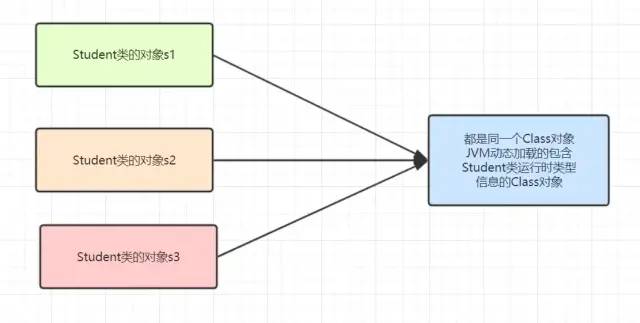
Class类的对象作用是运行时提供或获得某个对象的类型信息
反射的基本使用
获取 Class 类对象
获取反射中的Class对象有三种方法。
第一种,使用 Class.forName 静态方法。
Class class1 = Class.forName("reflection.TestReflection");第二种,使用类的.class 方法
Class class2 = TestReflection.class;第三种,使用实例对象的 getClass() 方法。
TestReflection testReflection = new TestReflection();Class class3 = testReflection.getClass();
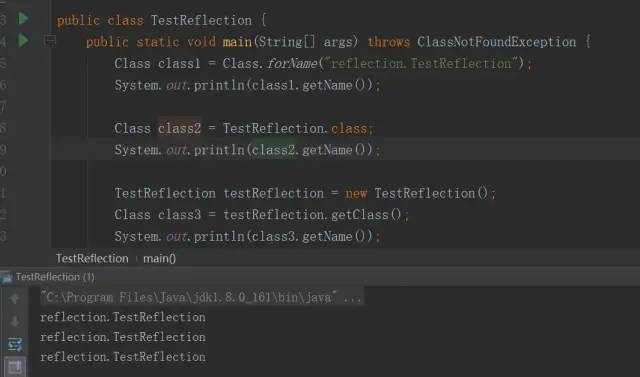
反射创造对象,获取方法,成员变量,构造器
本小节学习反射的基本API用法,如获取方法,成员变量等。
反射创造对象
通过反射创建类对象主要有两种方式:
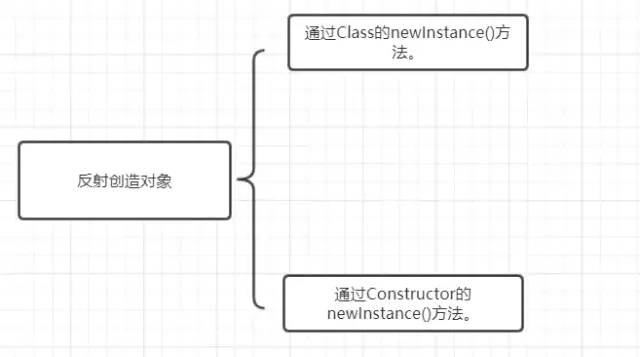
实例代码:
//方式一Class class1 = Class.forName("reflection.Student");Student student = (Student) class1.newInstance();System.out.println(student);//方式二Constructor constructor = class1.getConstructor();Student student1 = (Student) constructor.newInstance();System.out.println(student1);
运行结果:
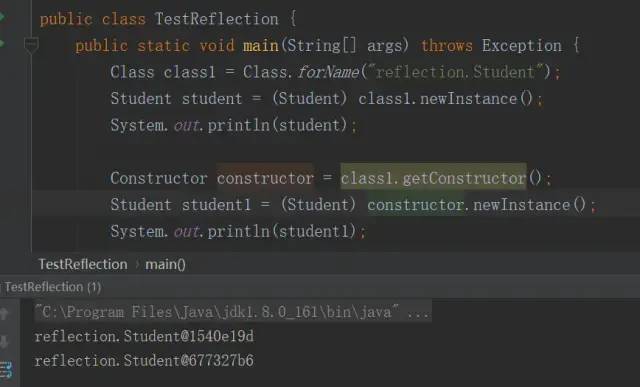
反射获取类的构造器
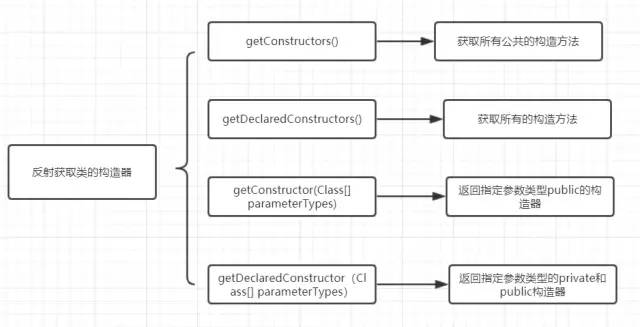
看一个例子吧:
Class class1 = Class.forName("reflection.Student");Constructor[] constructors = class1.getDeclaredConstructors();for (int i = 0; i < constructors.length; i++) {System.out.println(constructors[i]);}
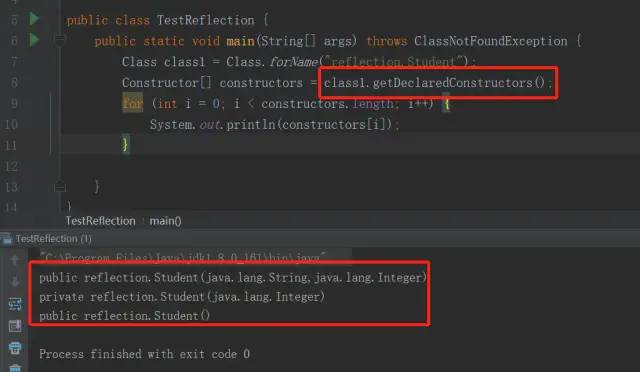
反射获取类的成员变量
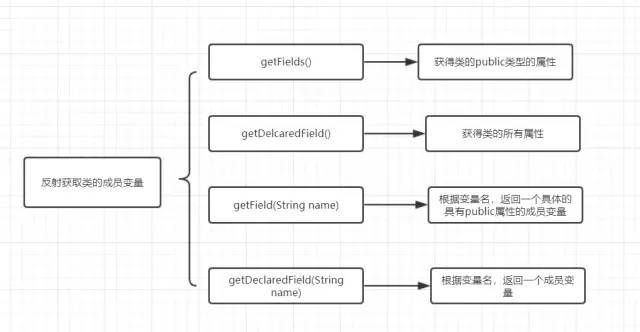
看demo:
// student 一个私有属性age,一个公有属性emailpublic class Student {private Integer age;public String email;}public class TestReflection {public static void main(String[] args) throws ClassNotFoundException, NoSuchFieldException {Class class1 = Class.forName("reflection.Student");Field email = class1.getField("email");System.out.println(email);Field age = class1.getField("age");System.out.println(age);}}
运行结果:
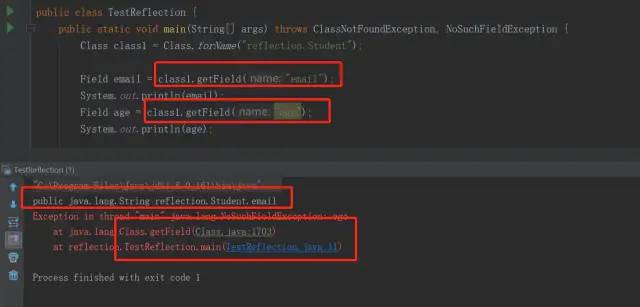
即getField(String name) 根据参数变量名,返回一个具体的具有public属性的成员变量,如果该变量不是public属性,则报异常。
反射获取类的方法

demo
public class Student {private void testPrivateMethod() {}public void testPublicMethod() {}}public class TestReflection {public static void main(String[] args) throws ClassNotFoundException, NoSuchFieldException {Class class1 = Class.forName("reflection.Student");Method[] methods = class1.getMethods();for (int i = 0; i < methods.length; i++) {System.out.println(methods[i]);}}}
运行结果:
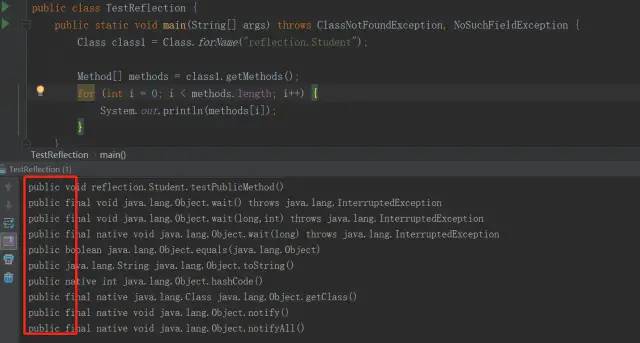
反射的实现原理
通过上一小节学习,我们已经知道反射的基本API用法了。接下来,跟着一个例子,学习反射方法的执行链路。
public class TestReflection {public static void main(String[] args) throws Exception {Class clazz = Class.forName("reflection.TestReflection");Method method = clazz.getMethod("target", String.class);method.invoke(null, "666");}public static void target(String str) {//打印堆栈信息new Exception("#" +str).printStackTrace();System.out.println("invoke target method");}}
堆栈信息反映出反射调用链路:
java.lang.Exception: #666invoke target methodat reflection.TestReflection.target(TestReflection.java:17)at sun.reflect.NativeMethodAccessorImpl.invoke0(Native Method)at sun.reflect.NativeMethodAccessorImpl.invoke(NativeMethodAccessorImpl.java:62)at sun.reflect.DelegatingMethodAccessorImpl.invoke(DelegatingMethodAccessorImpl.java:43)at java.lang.reflect.Method.invoke(Method.java:498)at reflection.TestReflection.main(TestReflection.java:11)
invoke方法执行时序图

我们跟着反射链路去看一下源码,先看Method的invoke方法:
public Object invoke(Object obj, Object... args)throws IllegalAccessException, IllegalArgumentException,InvocationTargetException{//校验权限if (!override) {if (!Reflection.quickCheckMemberAccess(clazz, modifiers)) {Class<?> caller = Reflection.getCallerClass();checkAccess(caller, clazz, obj, modifiers);}}MethodAccessor ma = methodAccessor; // read volatileif (ma == null) {ma = acquireMethodAccessor(); //获取MethodAccessor}//返回MethodAccessor.invokereturn ma.invoke(obj, args);}
由上可知道,Method 的 invoke 方法,其实是返回接口MethodAccessor的invoke方法。MethodAccessor接口有三个实现类,到底调用的是哪个类的 invoke 方法呢?
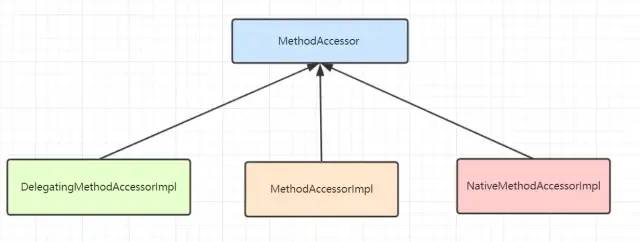
进入acquireMethodAccessor方法,可以看到MethodAccessor由ReflectionFactory 的 newMethodAccessor方法决定。
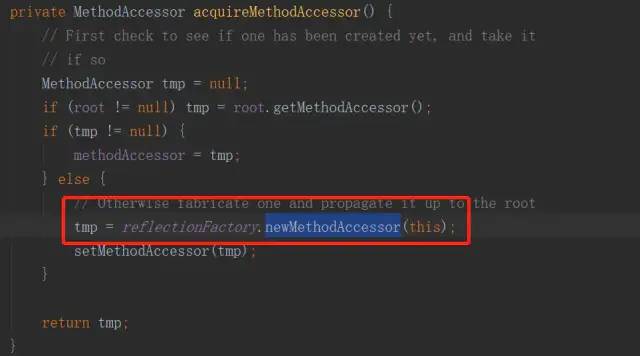
再进ReflectionFactory的newMethodAccessor方法,我们可以看到返回的是DelegatingMethodAccessorImpl对象,也就是说调用的是它的invoke方法。

再看DelegatingMethodAccessorImpl的invoke方法
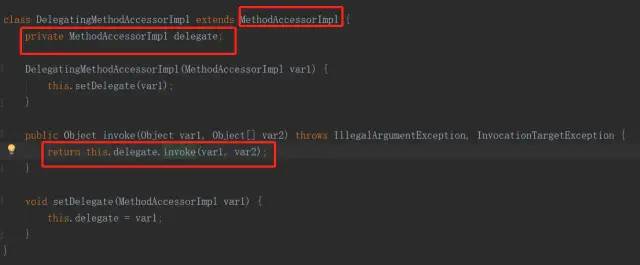
DelegatingMethodAccessorImpl的invoke方法返回的是MethodAccessorImpl的invoke方法,而MethodAccessorImpl的invoke方法,由它的子类NativeMethodAccessorImpl重写,这时候返回的是本地方法invoke0,如下

因此,Method的invoke方法,是由本地方法invoke0决定的,再底层就是c++相关了,有兴趣的朋友可以继续往下研究。
反射的一些应用以及问题
反射应用
反射是Java框架的灵魂技术,很多框架都使用了反射技术,如spring,Mybatis,Hibernate等。
JDBC 的数据库的连接
在JDBC连接数据库中,一般包括加载驱动,获得数据库连接等步骤。而加载驱动,就是引入相关Jar包后,通过Class.forName() 即反射技术,加载数据库的驱动程序。
Spring 框架的使用
Spring 通过 XML 配置模式装载 Bean,也是反射的一个典型例子。
装载过程:
将程序内XML 配置文件加载入内存中
Java类解析xml里面的内容,得到相关字节码信息
使用反射机制,得到Class实例
动态配置实例的属性,使用
这样做当然是有好处的:
不用每次都去new实例了,并且可以修改配置文件,比较灵活。
反射存在的问题
性能问题
java反射的性能并不好,原因主要是编译器没法对反射相关的代码做优化。
安全问题
我们知道单例模式的设计过程中,会强调将构造器设计为私有,因为这样可以防止从外部构造对象。但是反射可以获取类中的域、方法、构造器,修改访问权限。所以这样并不一定是安全的。
看个例子吧,通过反射使用私有构造器实例化。
public class Student {private String name;private Student(String name) {System.out.println("我是私有构造器,我被实例化了");this.name = name;}public void doHomework(String subject) {System.out.println("我的名字是" + name);System.out.println("我在做"+subject+"作业");}}public class TestReflection {public static void main(String[] args) throws Exception {Class clazz = Class.forName("reflection.Student");// 获取私有构造方法对象Constructor constructor = clazz.getDeclaredConstructor(String.class);// true指示反射的对象在使用时应该取消Java语言访问检查。constructor.setAccessible(true);Student student = (Student) constructor.newInstance("jay");student.doHomework("数学");}}
运行结果:
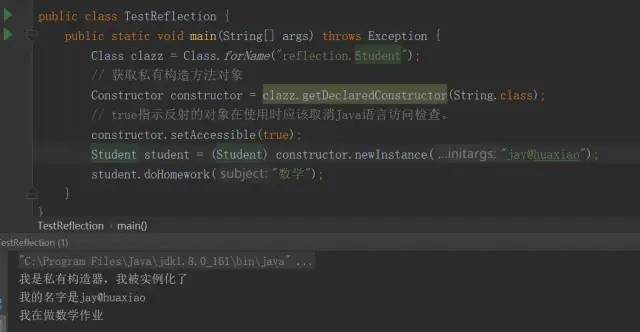
显然,反射不管你是不是私有,一样可以调用。所以,使用反射通常需要程序的运行没有安全限制。如果一个程序对安全性有强制要求,最好不要使用反射啦。

腾讯、阿里、滴滴后台面试题汇总总结 — (含答案)
面试:史上最全多线程面试题 !
最新阿里内推Java后端面试题
JVM难学?那是因为你没认真看完这篇文章

关注作者微信公众号 —《JAVA烂猪皮》
了解更多java后端架构知识以及最新面试宝典


看完本文记得给作者点赞+在看哦~~~大家的支持,是作者源源不断出文的动力
